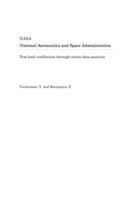
Test Load Verification Through Strain Data Analysis
Series:
A traditional binding acceptance criterion on polycrystalline structures is the experimental verification of the ultimate factor of safety. At fracture, the induced strain is inelastic and about an order-of-magnitude greater than designed for maximum expected operational limit. At this extreme strained condition, the structure may rotate and displace at the applied verification load such as to unk
NaN
VOLUME
English
Paperback

A traditional binding acceptance criterion on polycrystalline structures is the experimental verification of the ultimate factor of safety. At fracture, the induced strain is inelastic and about an order-of-magnitude greater than designed for maximum expected operational limit. At this extreme strained condition, the structure may rotate and displace at the applied verification load such as to unknowingly distort the load transfer into the static test article. Test may result in erroneously accepting a submarginal design or rejecting a reliable one. A technique was developed to identify, monitor, and assess the load transmission error through two back-to-back surface-measured strain data. The technique is programmed for expediency and convenience. Though the method was developed to support affordable aerostructures, the method is also applicable for most high-performance air and surface transportation structural systems. Verderaime, V. and Harrington, F. Marshall Space Flight Center ...
Price Comparison [India]
In This Series
Bestseller Manga
Trending NEWS




















